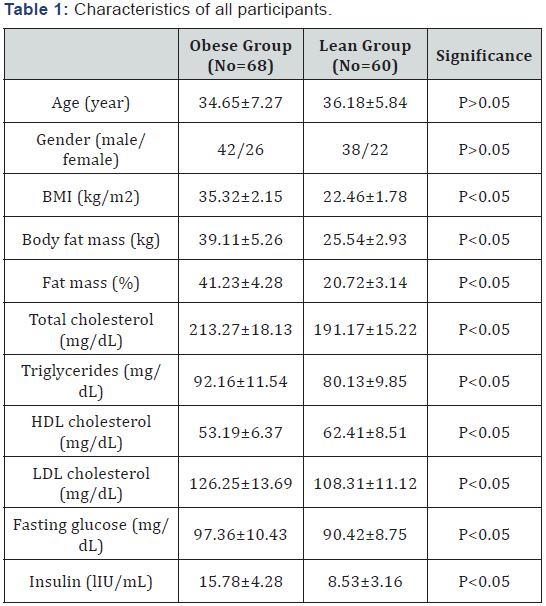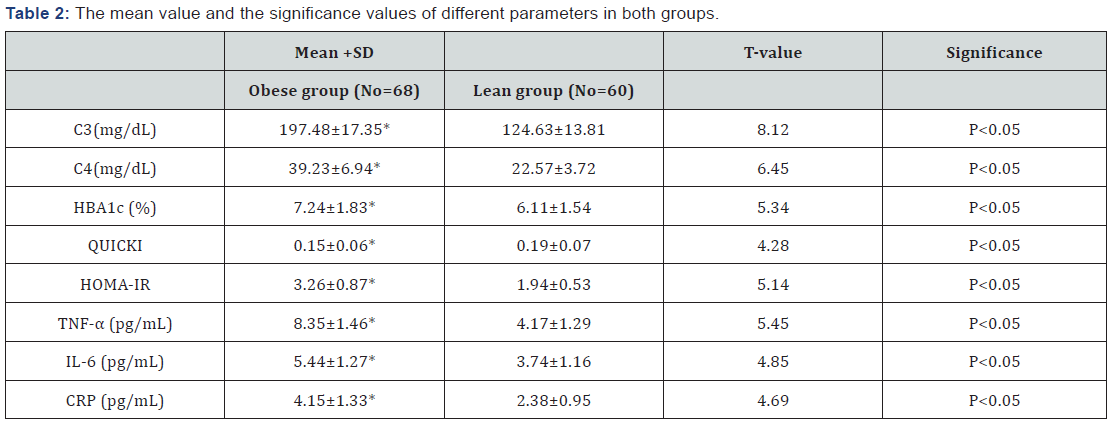Association between Complement System, Inflammatory Cytokines and Glucose Control in Obese Subjects
CURRENT RESEARCH IN DIABETES & OBESITY JOURNAL JUNIPER PUBLISHERS
Abstract
Background:Obesity is frequently characterized by chronic systemic inflammation and insulin resistance (IR). Obesity-associated low grade systemic inflammation is responsible for the complement system activation of which the third component (C3) plays the central role.
Objective:This study aimed to detect the association between complement system, inflammatory cytokines and glucose control in obese subjects.
Methods:Seventy-nine volunteers obese subjects were interviewed, only 68 of them met eligibility criteria, signed the consent form to participate in this study. Their age ranged from 26-43 years and their body mass index (BMI) ranged from 30 to 37kg/m2. In the other hand sixty lean subjects (BMI ≤25 kg/m2) were participated in the study as a control group, the mean age was 36.18±5.84 year and body mass index (BMI) was ≤25kg/m2. All participants who were assigned into two groups, group (A) consisted of 68 obese subjects and group (B) consisted of 60 lean subjects.
Results: The mean values of HBA1c, HOMA-IR, C3, C4, TNF-α, Il-6, CRP were significantly higher in the obese group than in the lean control group. In the other hand, the mean value of QUICKI was significantly lower in the obese group than in the lean control group. However, HBA1c and HOMA-IR showed a strong direct relationship with C3, C4, TNF-α, Il-6 and CRP, while QUICKI showed a strong inverse relationship with C3, C4, TNF-α, Il-6 and CRP in the obese group (P<0.05).
Conclusion:The present study suggests that in obese subjects there is an association between complement system, inflammatory cytokines and glucose control.
Keywords: Complement system; Cytokines; Obesity; Glucose control
Introduction
Recently, Obesity is a global medical problem as it affects about 13% of population worldwide [1]. Obesity is usually associated with impaired insulin sensitivity and insulin resistance [2,3]. Adipose tissue is a storage site and has secretory functions for some secretions of certain biological functions [4]. In addition, adipose tissues has adipocytes and non-adipocytes that include immune cells [5]. Adipose tissue in obese subjects contribute to excessive hepatic production of pro-inflammatory cytokines and serum complement proteins 3 &4 (C3 & C4) [6], which are associated with cardiovascular risk factors, insulin resistance, metabolic syndrome and type 2 diabetes mellitus (T2DM) [7,8]. However, there was an association between C3 & C4 with body mass index (BMI) and fat mass [9].
It is well-established that inflammation in obesity is characterized by a low-grade systemic inflammation [10] that leads to an increase in pro-inflammatory proteins such as C-reactive protein (CRP) and interleukin-6 (IL-6) [11] and some components of complement system [12]. The complement system is mainly associated with innate immunity. However, recent studies have shown that this system is involved in metabolic events [13]. The majority of complement components are synthesized mainly by hepatocytes, but also can be produced by other cells such as macrophages and adipocytes [14]. Recently, it was demonstrated that serum complement factor 3 (C3) synthesis can be up-regulated by pro-inflammatory cytokines IL-6 and interleukin- 1 beta (IL-1β), while serum complement factor 4 (C4) can be influenced by gamma interferon (IFN-γ) [15,16]. This study aimed to detect the association between complement system, inflammatory cytokines and glucose control in obese subjects.
Patients and Methods
Subjects
Seventy-nine volunteers obese subjects were interviewed, only 68 of them met eligibility criteria, signed the consent form to participate in the study at the Internal Medicine Department at King Abdul Aziz University Hospital. Participants were enrolled between January 2017 and April 2017. Scientific research ethical committee of the Faculty of Applied Medical Sciences, King Abdulaziz University approved this study. Their age ranged from 26-43 years and their body mass index (BMI) ranged from 30 to 37kg/m2. While, the exclusion criteria were pregnant women, smoking, patients with body mass index ≥40kg/m2, subjects taking any medications or herbal supplements, respiratory infection, liver, cardiovascular, renal, endocrine and thyroid diseases. In the other hand sixty lean subjects (BMI ≤25kg/m2) were participated in the study as a control group, the mean age was 36.18±5.84 year and body mass index (BMI) was ≤25kg/ m2. All participants who were enrolled into two groups, group (A) consisted of 68 obese subjects and group (B) consisted of 60 lean subjects.
Measurements
For all subjects, independent assessors who were blinded to group assignment and not involved in the routine treatment of the patients performed clinical evaluations and laboratory analysis. Body mass index (BMI) was calculated on the basis of weight (kilograms) and height (meters), and subjects were classified as normal weight (BMI 18.5-24.9kg/m2), overweight (BMI 25-29.9kg/m2), and obese (BMI ≥30kg/m2).
Measurement of inflammatory cytokines: Venous blood samples after a 12-hours fasting were centrifuged at +4 °C (1000=g for 10min). Interleukin-6 (IL-6) levels were analyzed by “Immulite 2000” immunassay analyzer (Siemens Healthcare Diagnostics, Deerfield, USA). However, tumor necrosis factoralpha (TNF-α) and C-reactive protein (CRP) levels were measured by ELISA kits (ELX 50) in addition to ELISA microplate reader (ELX 808; BioTek Instruments, USA).
Serum glucose, insulin and insulin resistance tests: Plasma glucose concentration and insulin were determined (Roche Diagnostics GmbH, Mannheim, Germany) using commercially available assay kits. Insulin resistance was assessed by homeostasis model assessment (HOMA-IR). HOMAIR = [fasting blood glucose (mmol/l) fasting insulin (mIU/ ml)]/22.5 [17]. However, insulin sensitivity was assessed by The quantitative insulin-sensitivity check index (QUICKI) using the formula: QUICKI=1/[log(insulin) + log(glucose)] [18]. All serum samples were analyzed in duplicates.
Measurement of complement system function: Biomarkers of C3 and C4 concentrations were measured from frozen serum samples stored at -80 °C by the immunochemiluminometric method (Advia Centaur XP, Siemens, Berlin, Germany).
Statistical Analysis
SPSS (Chicago, IL, USA) version 21 was used for statistical analysis of data. Quantitative variables were described as mean±SD. An independent t-test was used to compare mean values of each parameter among the groups. To observe possible relationships between C3, C4, HBA1c, HOMA-IR, QUICKI, TNF-α, Il-6, CRP, Pearson’s correlation coefficient (r) was used. All assumptions were carefully appreciated in each model we followed. All variables with p- value less than 0.05 were considered as statistical significance.
Results
Detailed baseline characteristics of the obese group and the lean group presented in Table 1. Comparison between both groups regarding baseline variables showed that there was no statistically significant difference between the both groups as regards age and gender, while the rest of variables the obese group showed significant differences (Table 1).

BMI: Body Mass Index; HDL-c: High-density Lipoprotein Cholesterol; LDL-c: Low-Density Lipoprotein Cholesterol; (*) indicates a significant difference between groups, P < 0.05.

C3: Serum Complement Factor 3; C4: Serum Complement Factor 4; HBA1c: Glycosylated Hemoglobin; HOMA-IR: Homeostasis Model Assessment-Insulin Resistance (HOMA-IR) Index; QUICKI: The Quantitative Insulin-Sensitivity Check Index; TNF-α: Tumor Necrosis Factor -Alpha; IL-6: Interleukin-6; CRP: C-reactive Protein; (*) indicates a significant difference between groups, P<0.05.The mean values of HBA1c, HOMA-IR, C3, C4, TNF-α, Il-6, CRP were significantly higher in the obese group than in the lean control group. In the other hand, the mean value of QUICKI was significantly lower in the obese group than in the lean control group (Table 2). However, HBA1c and HOMA-IR showed a strong direct relationship with C3, C4, TNF-α ,Il-6 and CRP, while QUICKI showed a strong inverse relationship with C3, C4, TNF-α, Il-6 and CRP in the obese group (Table 3) (P < 0.05).

Discussion
Obesity is usually associated with systemic low-grade inflammation which is responsible for complement system and macrophage infiltration [19,20]. which are linked with insulin resistance, T2DM and metabolic syndrome [21]. The complement system is mainly associated with innate immunity in addition to be involved in metabolic events [22]. Certainly, complement components C3 and C4 are associated with diabetes cardiovascular risk and the metabolic syndrome [23-25].
Concerning inflammatory markers, the results of the present study showed significantly higher values of TNF-α, IL-6 and CRP in obese than the lean control group. Researchers have found that plasma levels of CRP, TNF-α, IL-6 and other inflammatory mediators are elevated in subjects with obesity [26-28]. In correlation analysis, HBA1c and HOMA-IR showed a strong direct relationship with TNF-α, Il-6 and CRP, while QUICKI showed a strong inverse relationship with TNF-α, Il-6 and CRP in the obese group. Our findings are similar to many case-controlled researches demonstrated a direct association between HbA1c and inflammatory cytokines [29-36].
Regarding the values of C3 and C4, the present study showed significantly higher values of C3 and C4 in the obese group than the lean group. Our findings agreed with Wlazlo & colleagues [37] enrolled 532 individuals in their cohort study and reported that there was an association between the degree of body fat and the C3 level [37]. However, several studies reported that C3 and C4 correlated with CRP and other inflammatory markers [38,39]. However, in correlation analysis, HBA1c and HOMA-IR showed a strong direct relationship with C3 and C4, while QUICKI showed a strong inverse relationship with C3 and C4 in the obese group. Our findings agreed with Phillips et al. [40] reported that among 1754 with metabolic syndrome, they found an association between C3 and insulin resistance, abdominal obesity, low HDL and smoking [40]. Similarly, Koistinen et al. [41] reported that C3 level was associated with insulin resistance in in obese nondiabetic subjects and type 2 diabetics [41]. In addition, Onat & colleagues [42] conducted a cohort study on 1220 adult subjects of general population and they reported that C3 level was associated significantly with waist circumference, triglycerides, CRP, smoking and insulin resistance [42]. Moreover, Wlazlo et al. [43] conducted a 7-year prospective analysis on type 2 diabetes mellitus and found an independent association between C3 level and insulin resistance [43]. In the other hand, Bratti & colleagues [44] reported that C3 and C4 were significantly higher with positive correlation with HOMA-IR in morbidly obese patients than lean subjects, while following bariatric surgery there was reduction in triacylglycerol and increase in HDL and insulin sensitivity 6months following surgery [44].
Conclusion
The present study suggests that in obese subjects there is an association between complement system, inflammatory cytokines and glucose control.
Acknowledgment
The author thanks Prof. Mohammed Tayeb for his skillful assistance in selection of participants, laboratory analysis and during clamp procedures of this study. In addition, author is grateful for the cooperation and support of all patients who participated in this study.
To Know More About Current Research in Diabetes & Obesity Journal Please click on:
https://juniperpublishers.com/crdoj/index.php
To Know More About Open Access Journals Please click on: https://juniperpublishers.com/index.php



Comments
Post a Comment